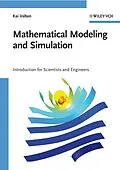This concise and clear introduction to the topic requires only basic knowledge of calculus and linear algebra - all other concepts and ideas are developed in the course of the book. Lucidly written so as to appeal to undergraduates and practitioners alike, it enables readers to set up simple mathematical models on their own and to interpret their results and those of others critically. To achieve this, many examples have been chosen from various fields, such as biology, ecology, economics, medicine, agricultural, chemical, electrical, mechanical and process engineering, which are subsequently discussed in detail.
Based on the author`s modeling and simulation experience in science and engineering and as a consultant, the book answers such basic questions as: What is a mathematical model? What types of models do exist? Which model is appropriate for a particular problem? What are simulation, parameter estimation, and validation?
The book relies exclusively upon open-source software which is available to everybody free of charge. The entire book software - including 3D CFD and structural mechanics simulation software - can be used based on a free CAELinux-Live-DVD that is available in the Internet (works on most machines and operating systems).
Autorentext
Kai Velten is a professor of mathematics at the University of Applied Sciences, Wiesbaden, Germany, and a modeling and simulation consultant. Having studied mathematics, physics and economics at the Universities of Gottingen and Bonn, he worked at Braunschweig Technical University (Institute of Geoecology, 1990-93) and at Erlangen University (Institute of Applied Mathematics, 1994-95). From 1996-2000, he held a post as project manager and group leader at the Fraunhofer-ITWM in Kaiserslautern (consultant projects for the industry). His research emphasizes differential equation models and is documented in 34 scientific publications and one patent.
Inhalt
Preface xiii
1 Principles of Mathematical Modeling 1
1.1 A Complex World Needs Models 1
1.2 Systems, Models, Simulations 3
1.2.1 Teleological Nature of Modeling and Simulation 4
1.2.2 Modeling and Simulation Scheme 4
1.2.3 Simulation 7
1.2.4 System 7
1.2.5 Conceptual and Physical Models 8
1.3 Mathematics as a Natural Modeling Language 9
1.3.1 InputOutput Systems 9
1.3.2 General Form of Experimental Data 10
1.3.3 Distinguished Role of Numerical Data 10
1.4 Definition of Mathematical Models 11
1.5 Examples and Some More Definitions 13
1.5.1 State Variables and System Parameters 15
1.5.2 Using Computer Algebra Software 18
1.5.3 The Problem Solving Scheme 19
1.5.4 Strategies to Set up Simple Models 20
1.5.4.1 Mixture Problem 24
1.5.4.2 Tank Labeling Problem 27
1.5.5 Linear Programming 30
1.5.6 Modeling a Black Box System 31
1.6 Even More Definitions 34
1.6.1 Phenomenological and Mechanistic Models 34
1.6.2 Stationary and Instationary models 38
1.6.3 Distributed and Lumped models 38
1.7 Classification of Mathematical Models 39
1.7.1 From Black to White Box Models 40
1.7.2 SQM Space Classification: S Axis 41
1.7.3 SQM Space Classification: Q Axis 42
1.7.4 SQM Space Classification: M Axis 43
1.8 Everything Looks Like a Nail? 45
2 Phenomenological Models 47
2.1 Elementary Statistics 48
2.1.1 Descriptive Statistics 48
2.1.1.1 Using Calc 49
2.1.1.2 Using the R Commander 51
2.1.2 Random Processes and Probability 52
2.1.2.1 Random Variables 53
2.1.2.2 Probability 53
2.1.2.3 Densities and Distributions 55
2.1.2.4 The Uniform Distribution 57
2.1.2.5 The Normal Distribution 57
2.1.2.6 Expected Value and Standard Deviation 58
2.1.2.7 More on Distributions 60
2.1.3 Inferential Statistics 60
2.1.3.1 Is Crop A's Yield Really Higher? 61
2.1.3.2 Structure of a Hypothesis Test 61
2.1.3.3 The t test 62
2.1.3.4 Testing Regression Parameters 63
2.1.3.5 Analysis of Variance 63
2.2 Linear Regression 65
2.2.1 The Linear Regression Problem 65
2.2.2 Solution Using Software 66
2.2.3 The Coefficient of Determination 68
2.2.4 Interpretation of the Regression Coefficients 70
2.2.5 Understanding LinRegEx1.r 70
2.2.6 Nonlinear Linear Regression 72
2.3 Multiple Linear Regression 74
2.3.1 The Multiple Linear Regression Problem 74
2.3.2 Solution Using Software 76
2.3.3 Cross-Validation 78
2.4 Nonlinear Regression 80
2.4.1 The Nonlinear Regression Problem 80
2.4.2 Solution Using Software 81
2.4.3 Multiple Nonlinear Regression 83
2.4.4 Implicit and Vector-Valued Problems 86
2.5 Neural Networks 87
2.5.1 General Idea 87
2.5.2 Feed-Forward Neural Networks 89
2.5.3 Solution Using Software 91
2.5.4 Interpretation of the Results 92
2.5.5 Generalization and Overfitting 95
2.5.6 Several Inputs Example 97
2.6 Design of Experiments 99
2.6.1 Completely Randomized Design 100
2.6.2 Randomized Complete Block Design 103
2.6.3 Latin Square and More Advanced Designs 104
2.6.4 Factorial Designs 106
2.6.5 Optimal Sample Size 108
2.7 Other Phenomenological Modeling Approaches 109
2.7.1 Soft Computing 109
2.7.1.1 Fuzzy Model of a Washing Machine 110
2.7.2 Discrete Event Simulation 111
2.7.3 Signal Processing 113
3 Mechanistic Models I: ODEs 117
3.1 Distinguished Role of Differential Equations 117
3.2 Introductory Examples 118
3.2.1 Archaeolo...
